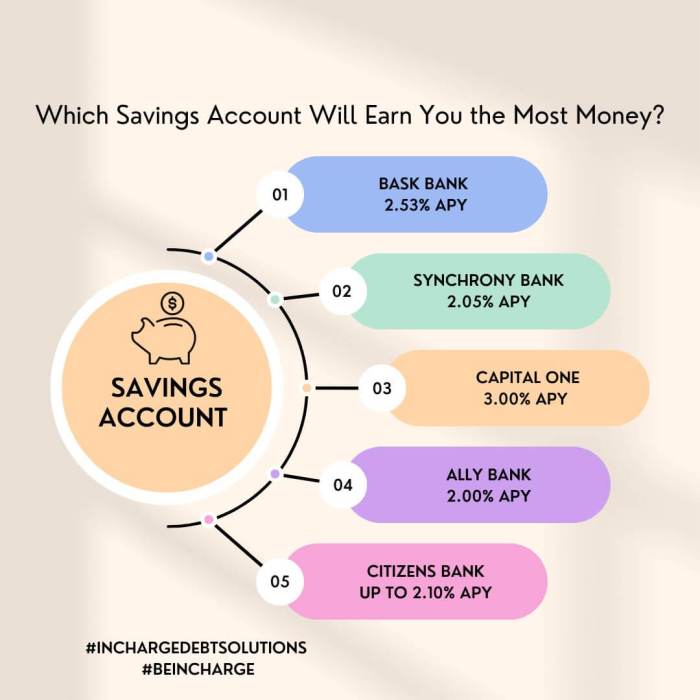Get ready to dive into the world of savings account options, where we break down the ins and outs of high-yield accounts, traditional savings options, and money market choices. Buckle up for a ride filled with knowledge and tips to make the most of your savings journey.
In this guide, we’ll explore the different types of savings accounts, factors to consider when choosing one, how to open an account, and ways to effectively manage your savings.
Types of Savings Accounts
When it comes to saving that hard-earned cash, there are a few options to choose from. Let’s break down the different types of savings accounts available to help you decide which one suits your financial goals.
High-Yield Savings Accounts
Looking to maximize your savings with higher interest rates? A high-yield savings account might be the way to go. These accounts typically offer better interest rates compared to traditional savings accounts, allowing your money to grow faster over time.
Traditional Savings Accounts
If you prefer a more straightforward approach to saving, a traditional savings account might be the right choice for you. These accounts are offered by banks and credit unions and provide a safe place to store your money while earning interest. While the interest rates may not be as high as high-yield accounts, they are still a reliable option for saving.
Money Market Accounts
Money market accounts combine the best of both worlds – the high interest rates of a high-yield savings account with the accessibility of a checking account. These accounts typically require a higher minimum balance to open and maintain but offer competitive interest rates to help your money grow faster.
Factors to Consider When Choosing a Savings Account

When choosing a savings account, there are several key factors to consider that can impact your overall savings strategy. These factors include interest rates, fees, minimum balance requirements, and accessibility.
Interest Rates
Interest rates play a crucial role in determining how much your savings will grow over time. Higher interest rates mean your money will earn more through compound interest. It’s important to compare the annual percentage yield (APY) of different savings accounts to maximize your earnings.
Fees
Be mindful of any fees associated with the savings account, such as maintenance fees, overdraft fees, or ATM fees. These fees can eat into your savings if you’re not careful. Look for accounts with minimal fees or fee-waiver options to avoid unnecessary charges.
Minimum Balance Requirements
Some savings accounts require a minimum balance to open the account or to avoid monthly maintenance fees. Make sure you can comfortably meet the minimum balance requirement to maximize the benefits of the account without incurring additional charges.
Accessibility
Consider how easily you can access your savings when needed. Look for savings accounts with online and mobile banking options, as well as a wide network of ATMs for convenient withdrawals. Accessibility is key to managing your savings effectively.
The interest on savings accounts is typically calculated daily and paid out monthly. This means you earn interest on your principal balance plus any interest that has already been credited to your account.
FDIC Insurance
Federal Deposit Insurance Corporation (FDIC) insurance protects your savings in case the bank fails. It covers up to $250,000 per depositor, per bank, per account ownership category. Choosing a savings account with FDIC insurance ensures your money is safe and secure.
Opening a Savings Account
When it comes to opening a savings account, there are a few key steps to follow to ensure a smooth process and make the right choices.
Choosing the Right Bank or Financial Institution
Before opening a savings account, it’s important to do some research and choose the right bank or financial institution for your needs.
- Consider the interest rates offered by various banks.
- Look into the fees associated with the savings account.
- Check the convenience of access to ATMs or online banking services.
- Read reviews or ask for recommendations from friends and family.
Documentation Required
When you’re ready to open a savings account, make sure you have the necessary documentation on hand to streamline the process.
- Valid identification such as a driver’s license, passport, or state ID.
- Social Security number or Tax Identification number.
- Proof of address, such as a utility bill or lease agreement.
- Initial deposit amount, which varies depending on the bank.
Managing a Savings Account
When it comes to managing a savings account, there are a few key strategies that can help you maximize your savings and reach your financial goals faster.
One effective way to boost your savings is by setting up automatic transfers from your checking account to your savings account. By automating this process, you ensure that a portion of your income goes directly into savings without you having to remember to do it manually. This can help you build your savings consistently over time.
Maximizing Savings Strategies:
- Set a specific savings goal and create a budget to track your progress.
- Take advantage of high-yield savings accounts to earn more interest on your savings.
- Avoid unnecessary spending and focus on needs over wants to save more.
Importance of Monitoring Statements:
Regularly reviewing your savings account statements is crucial to ensure that your funds are secure and that there are no unauthorized transactions. Monitoring your account activity can also help you track your savings progress and identify areas where you can cut back on expenses to save more.
Remember, small changes in your savings habits can lead to significant growth in your savings over time.
